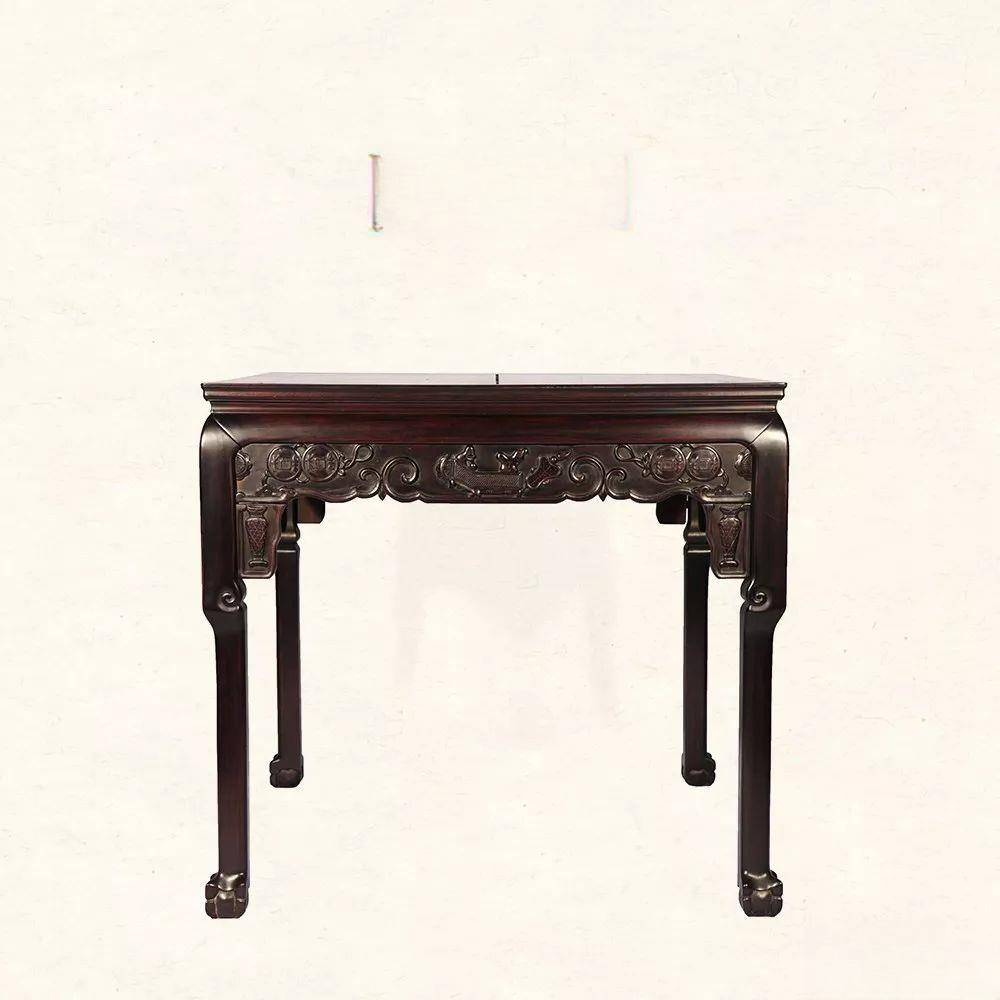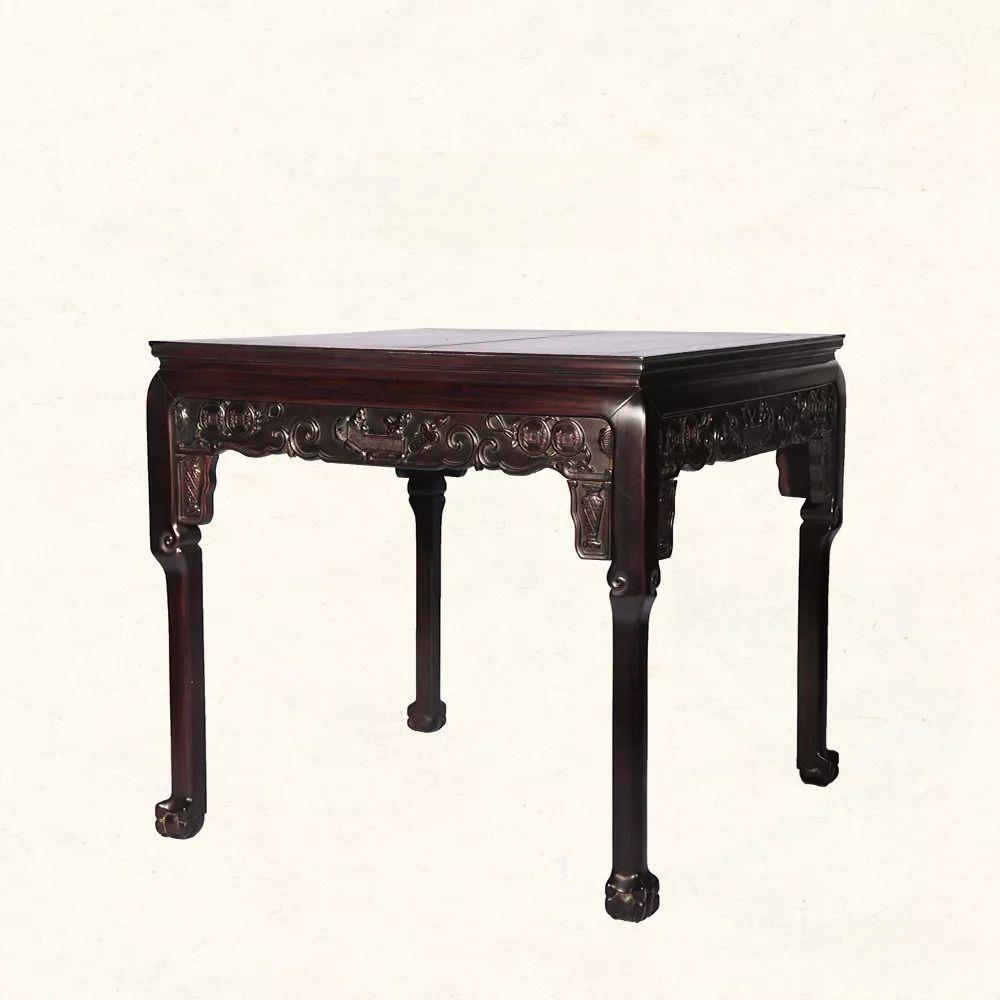Furniture丨The ultimate oriental aesthetic charm · Eight Treasures Eight Immortals Table

Fisherman's Song Art Salon
It is human's aesthetic instinct to perceive beauty. Due to historical reasons, it has only been a few hundred years since Ming and Qing furniture was called a work of art, and its recognition and understanding is still in its infancy. Through a certain degree of contact with Ming and Qing furniture, it is not difficult for us to appreciate the aesthetic implications that inspire people's aesthetic inspiration. These exquisite artistic contents have passed on an enduring artistic vitality.

尺寸:枱93cm×93cm×89cm
Material: Rosewood

The Eight Immortals Table is a large square table that can seat two people on each side, and can seat eight people around it, so it is also called the Eight Immortals Table. In ancient times, it was mainly placed in the south-facing position of the main hall of the living room, with an offering table or offering table behind it, and was often used for eating and drinking.
The rosewood is dark red in color and has a fine and even texture. The tabletop is square, smooth and round, with precise mortise and tenon joints. The tabletop has a waistband and the tooth plate is embossed with the typical eight treasures pattern of the Qing Dynasty, symbolizing good luck and wealth.
The Eight Treasures are also known as the Eight Auspicious Signs or Eight Auspicious Symbols. They are the treasure bottle, the treasure cover, the twin fish, the lotus, the right-handed conch, the auspicious knot, the victory banner, and the Dharma wheel. They are eight objects that represent auspiciousness and good fortune in Tibetan Buddhism. Temples, religious objects, instruments, pagodas, Tibetan and Mongolian houses, clothing, and paintings often use these eight patterns as decorations to symbolize auspiciousness, happiness, and perfection. According to legend, when Sakyamuni was born, the heavens offered various offerings, and these eight treasures were offered by the gods. Some say they represent the eight parts of Sakyamuni's body when he became a Buddha, and each has its own meaning.

[Vase]: It represents the neck of the Buddha. As the Dharma flows out of the Buddha's mouth, the vase is also a symbol of the Dharma and doctrine. It is said that the vase in Buddhist temples contains pure water (nectar) and gems, and a peacock feather or a wish-fulfilling tree is inserted in the vase. It symbolizes auspiciousness, purity and wealth, as well as the treasure without dew, perfect blessings and wisdom, and eternal life.
[Huagai]: It represents the top of the Buddha's head. In the Han area, it is called the precious umbrella. It is placed on the top of the Buddha's head to block the wind and sun. In ancient India, umbrellas were used by nobles and royal families to symbolize dignity and power. In Buddhism, umbrellas symbolize blocking demons and protecting the Dharma. Tibetan Buddhism also believes that the precious umbrella symbolizes the authority of Buddhist teachings.
[Pisces]: Represents the eyes of Buddha. This represents the compassionate gaze of Buddha upon all living beings, and is also a symbol of wisdom. Fish swim freely in the water. Buddhism uses it to represent practitioners who transcend the world and are free and open-minded. It also symbolizes revival, immortality, and rebirth.
[Lotus]: It represents the tongue of Buddha. The lotus grows out of mud but remains unstained, and is extremely pure. Tibetan Buddhism believes that the lotus symbolizes the ultimate goal, which is to achieve enlightenment.
[Right-handed conch]: Represents the three neck lines of the Buddha. The sound of the Buddha's Dharma is vast and melodious, as pure and beautiful as a right-handed conch, which brings all sentient beings to liberation. Conch shells are often blown during Dharma assemblies. In Tibet, the right-handed white conch shell is the most revered and is regarded as a symbol of fame that spreads far and wide throughout the three thousand worlds, and also symbolizes the endless echoing voice of Bodhidharma.
[Auspicious knot]: It represents the heart of Buddha, and is also called the endless knot, because it has no beginning or end, representing the endless Dharma of Buddha. This knot can also be seen as two "卍" characters interlaced, so it also represents the heart channel. In Tibetan Buddhism, this knot is often worn by believers for blessing.
[Zunsheng Banner]: It represents the Buddha's supreme enlightenment, which is the victory of Buddhism. Therefore, it is represented by the Zunsheng Banner. Zunshengchuan is a kind of military flag in ancient India, representing victory. Here it represents the elimination of all troubles and demons, the great victory, the ultimate liberation, and the enlightenment of the right fruit.
【Dharma Wheel】: Represents the palm of Buddha. In ancient India, the wheel was a powerful weapon. Later, it was borrowed by Buddhism to symbolize that the Dharma rotates like a wheel and never extinguishes.

The four legs are slender and high, straight down, and the straight twin legs are turned outward like tiger claws. The overall feeling is stable and majestic, and the shape is simple and steady, solemn and imposing. This table is made of precious materials, finely crafted, and decorated with extraordinary splendor, reflecting the artistic characteristics of elegance and grandeur. Whether in terms of the selected materials or the style of decorative carving, it is a fine piece of rosewood furniture.

From the perspective of structure and use, the popularity of the Eight Immortals Table is inevitable. It is generally believed that among large furniture, the Eight Immortals Table has the simplest structure, the most economical materials, and is also the most practical furniture. It is easy to use, square in shape, and solid in structure. It is friendly, peaceful, and yet majestic, and has a strong sense of stability, which also makes the Eight Immortals Table a central hall furniture that can be worn in elegant halls. No matter whether the hall decoration is elegant, simple, or even rough, as long as the space is not particularly cramped, placing an Eight Immortals Table and two chairs on both sides will create a very stable feeling, like a great scholar, stable and peaceful.